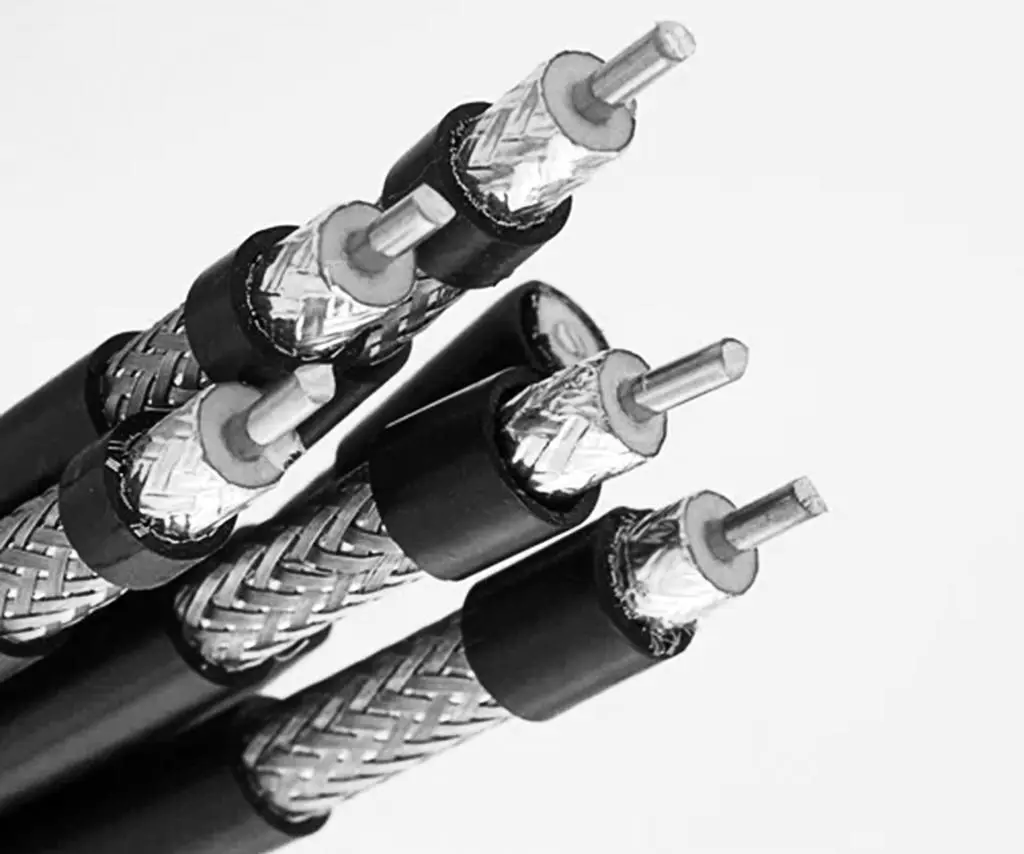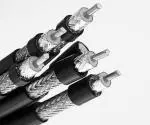Whether you’re setting up a new sound system or just trying to get your old speakers working again, choosing the right cables is crucial. Though they may look similar on the outside, not all cables are created equal. Coaxial and speaker cables in particular have some key differences that impact how well audio signals are transmitted.

Can You Use Coaxial as a Speaker Cable: Table of Contents
Coaxial cable is composed of a central copper conductor surrounded by insulation and an outer braided shield. The shielding helps prevent electromagnetic interference from external sources degrading the signal flowing through the inner conductor. Coaxial cables are commonly used for weaker signals like cable TV connections, satellite TV, and Ethernet networks.
Speaker cables have a simpler design – just one or more unshielded inner copper conductors. Without a shield, they are fully exposed and able to transmit a strong, uninhibited audio signal from an amplifier to a set of passive speakers. The lack of shielding does make them prone to picking up electromagnetic interference, but for short speaker cable runs this isn’t a major issue.
So while coaxial and speaker cables may appear similar, their internal construction differs significantly. Coaxial cables are optimized for stopping interference on low-power signals, whereas speaker cables are designed to efficiently deliver a robust audio signal. This makes coaxial cables less suitable for speaker connections, though it is possible to rig them up in a pinch. Understanding the core differences between these two cable varieties will help ensure you choose the right cable for the job.
Coaxial Cables vs Speaker Cables
To understand the key differences between coaxial and speaker cables, we first need to look at how each one is constructed.
What is a Coaxial Cable?
Coaxial cable contains a single copper conductor at its core, surrounded by insulation to prevent current leakage. Wrapped around the insulated center conductor is a woven tubular shield made of braided copper wires or foil. The shield acts as a Faraday cage, blocking external electromagnetic interference from disrupting the signal in the inner conductor. The entire cable is protected by an outer plastic jacket.
Because of its shielded design, coaxial cable is ideal for carrying weaker electrical signals that are susceptible to interference, like cable TV, antenna, and Ethernet connections. The electromagnetic shielding prevents unwanted outside signals from mingling with the data signal flowing through the inner conductor. Thinner gauge wire is used since these applications only require a low-powered signal.
What is Speaker Cable?
Speaker cables have a much simpler design – just one or more unshielded copper conductors inside an outer plastic jacket. Without the woven tubular shield found in coaxial cables, speaker cables do not provide any protection against electromagnetic interference. However, this allows the audio signal to transmit fully and without restriction from the amplifier to the speakers. Speaker cables also utilize thicker gauge copper wire to handle the greater electrical current and power demands of audio equipment.
Key Differences between Coaxial and Speaker Cables
In summary, the key differences between the two cable varieties are:
| Feature | Coaxial Cable | Speaker Cable |
|---|---|---|
| Shielding | Yes | No |
| Wire Gauge | Thinner | Thicker |
| Signal Power | Low | High |
| Usage | Cable TV, Ethernet, etc. | Amplifiers to speakers |
The specialized designs make coaxial and speaker cables suited for very different purposes. While coaxial cables focus on interference reduction, speaker cables prioritize unfiltered audio signal transmission.
Can You Use Coaxial as Speaker Cable?
While it is technically possible to use coaxial cable in place of regular speaker cable, it is not recommended as a permanent solution. There are a few issues that arise from using coaxial cable to connect an amplifier to passive speakers.
First, the smaller gauge inner conductor and presence of shielding in coaxial cables means the speaker audio signal will be weakened. This results in lower maximum volume as energy is lost in the thinner cable. The shielding also acts as a barrier that can potentially distort the musical signal. Any bends or kinks in the coaxial cable will degrade audio quality.
More seriously, forcing an amplifier to drive passive speakers through a coaxial cable risks equipment damage over time. Amplifiers are designed to work with the thicker, unshielded copper wires found in speaker cables. The added resistance and impedance mismatch of coaxial cable can overheat amplifiers and speakers.
Converting Coaxial to Speaker Cable
However, in a pinch, coaxial cable can be rigged to work as makeshift speaker cable. This involves removing the coaxial connectors on both cable ends to expose the inner conductor. The length of speaker cable needed between the amp and speakers should be measured, then the same amount of coaxial shielding peeled away. For minimal signal loss, the woven tubular shield and inner plastic insulation need to be stripped. Finally, the coaxial inner wire is connected on the positive (red) speaker terminal.
While functional, this cobbled together solution loses all the benefits of proper speaker cable. The lack of shielding also means it may pick up unwanted interference. As soon as possible, we recommend replacing the coaxial cable with the correctly gauged, purpose-built speaker cable for your system. This will provide clean, full-range sound and safe equipment operation.
Coaxial vs Speaker Cables: FAQs
Using coaxial cable as speaker wire is possible but questionable. For those considering this DIY workaround, there are a number of important questions that arise. Below we have compiled the most frequently asked questions about utilizing coaxial cables to connect amplifiers and passive speakers. Read on for expert answers covering coaxial vs. speaker cables, converting coaxial wires, cable connectors, interference, signal loss, and more. With this FAQ guide, you’ll have all the key info to determine if coaxial can work temporarily as speaker cable in your situation.
Can coaxial carry audio?
Yes, coaxial cable is capable of transmitting stereo audio signals. The center conductor is used for the left channel while the braided tubular shield carries the right channel audio. Coaxial cables are commonly used to route audio signals from AV components like Blu-ray players and gaming consoles. They can also transmit video signals, making coaxial a versatile jack-of-all-trades connection option.
How do I connect coaxial cable to speaker wire?
It is possible to attach a coaxial cable to speaker wire, though this is not recommended as a permanent method. You’ll need to cut back and remove the braided tubular shielding as well as inner plastic insulation, exposing the center conductor. This modified coaxial wire can then be twisted together with the positive speaker cable conductor, normally indicated by red insulation. Use caution as any bare wire is a potential shock hazard.
What cables can you use for speakers?
While lamp cord or other basic copper wire can physically connect speakers, we recommend using cables specifically designed as speaker wire. These are engineered with the proper thickness and materials to efficiently transmit amplifier power with minimal loss. Choose an appropriate gauge that matches your amplifier’s wattage and speakers’ impedance rating. Using the wrong cable can negatively affect sound quality and potentially damage equipment. Speaker cable delivers the best audio fidelity and safety.
What gauge coaxial cable is best for speakers?
For speaker connections, we recommend a thick 12 or 14 gauge coaxial cable to handle the higher power levels. Thinner coaxial meant for video or TV will not work well.
Can I splice coaxial and speaker wire together?
It’s possible but not ideal – use crimp connectors or solder for a solid connection. Twisting the wires together may lead to signal loss and distortion.
Is coaxial cable directional?
No, coaxial cable is non-directional and can carry a signal in either direction unlike Ethernet cable. This makes it a little simpler to use between amps and speakers.
Can I run coaxial next to speaker cables?
It’s best to keep some distance between the coaxial and speaker cables to avoid signal interference between the different cable types.
Is coaxial cable susceptible to interference?
Coaxial’s shielding makes it less prone to EMI, but it can still pick up interference from power cables, florescent lights, and other electronics.
Does coaxial cable lose quality over long distances?
Like speaker cable, coaxial will experience some signal degradation over very long cable runs due to resistance. Keep runs under 50 feet.
What are the downsides to using coaxial speaker cable?
Downsides include weaker volume, distortion, equipment damage risk, signal loss, and lack of proper connectors.
How many volts can speaker wire handle?
Speaker cables are very high current but low voltage. They can safely handle 15-100 volts from typical amplifiers.
Can I use an RCA to banana plug adapter for speakers?
Yes, these adapters allow connecting coaxial/RCA cables to speaker posts. Quality may vary.
What causes static and buzzing from coaxial connected speakers?
This is usually caused by ground loops or EMI. Isolate or replace cables to remedy.
Is copper-clad aluminum (CCA) coaxial good for speakers?
Pure copper coaxial is better. CCA may have higher resistance leading to power loss.
Is oxygen-free copper coaxial better than standard?
Oxygen-free is optimal for best conductivity and clarity. But standard copper coax works fine.

